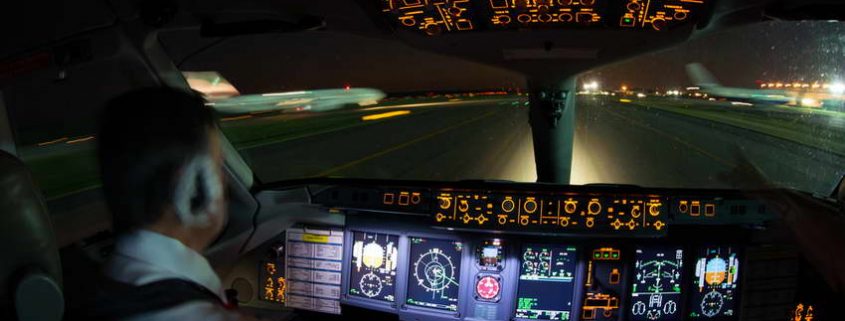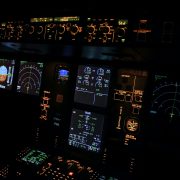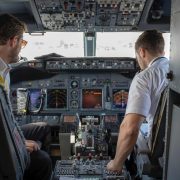Entering the cockpit at night
Why is it important to dim the galley and flight deck threshold lights before entering the flight deck at night?
Entering the cockpit at night does require additional minor preparation and awareness on the part of the flight attendant. Take a look at the photo included in this story. Notice the image was taken at night, but more importantly, notice the interior lighting of the cockpit. It uses primarily amber and red lighting, with minimal white light. The illumination of white light, in reality, isn’t that bright, it appears brighter than what it is due to photo exposure. Amber and red lighting have minimal, if no effect to a person’s night vision, that’s why the majority of switches and buttons are in those two colors. Of all crewmembers onboard the aircraft, the flight crew need to maintain their night vision adaptation.
So, how does this involve flight attendants? On occasion during flight, flight attendants will enter and exit the flight deck for various reasons. When this happens, aside from security procedures for entering/exiting the flight deck, the cabin light in the forward galley can directly affect the flight crew’s night vision. Whenever the Flight deck door needs to be opened or closed, the forward galley lights should be turned to the dim setting or off so the remaining flight crew member can maintain their night vision.
You may wonder, “if we’re in cruise flight and the autopilot is engaged, why does it matter whether the flight crewmembers can maintain their night vision or not? Isn’t there an instrument they use to monitor for air traffic?” They do have an instrument called Traffic Collision Avoidance System, or TCAS that gives alerts to other air traffic that is nearby. Additionally, air traffic control (ATC) does monitor air traffic and provides separation between aircraft. However, when there is traffic nearby, ATC will tell the pilots the location, altitude, and heading of the traffic alert. The pilots then need to look for the aircraft and identify its location in relation to them. If their night vision adaptation is disrupted, it can be difficult, if not impossible, for the flight crew to look out the window and identify the reported aircraft.
What you may or may not know is, when it comes to night vision and looking to identify an object, you use more of your peripheral vision to see. What’s directly in the center of your vision may not be noticed, but when you turn your head a little bit, your peripheral vision sees it.
So, since you know this, remember to always dim or turn off the forward galley lights whenever you are going to open the flight deck door. More than crewmembers enter the flight deck, so does harmful bright light.
Additional related reading:
Scientific American: Why does it take so long for our vision to adjust to a darkened theater after we come in from bright sunlight?
West Texas A&M University: How long does it take our eyes to fully adapt to darkness? By Dr. Christopher S. Baird
Quartz: The Pilots of Instagram, beautiful views from the cockpit, violating rules of the air.
Aviation.Stackexchange.com: How do pilots see at night if airplanes don’t have front lights?






Leave a Reply
Want to join the discussion?Feel free to contribute!